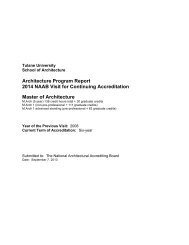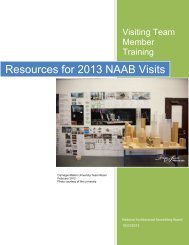Architecture Program Report Tulane University New Orleans ...
Architecture Program Report Tulane University New Orleans ...
Architecture Program Report Tulane University New Orleans ...
Create successful ePaper yourself
Turn your PDF publications into a flip-book with our unique Google optimized e-Paper software.
Technological Systems II (ATCS 310) (Professor Goodwin) are the first and<br />
second courses that deals specifically with sustainable design. This course<br />
occurs in the second year of the technology sequence, in a critical position<br />
to the whole of the curriculum. Other courses that deal with sustainability,<br />
and which all students go through are the URBANbuild microscale and<br />
macroscale curricula (Fourth year DSGN 410, 420). In Thesis, approaches<br />
to sustainable design are carried out in the GREENbuild (Professor Coker)<br />
and CITYbuild (Professor Harmon) Design Studios (DSGN 510, 520).<br />
Required electives which focus on sustainable design include Professor<br />
Klingman’s Sustainability and Tectonics (ATCS 430), a required elective<br />
course which approximately half the students take. Other courses which are<br />
notable for mention are those taught by Professors McNaughton, Rhodes,<br />
Cizek and Thomas under the heading of ATCS or PRST.<br />
16. <strong>Program</strong> Preparation<br />
Ability to prepare a comprehensive program for an architectural project,<br />
including assessment of client and user needs, a critical review of<br />
appropriate precedents, an inventory of space and equipment<br />
requirements, an analysis of site conditions, a review of the relevant laws<br />
and standards and assessment of their implication for the project, and a<br />
definition of site selection and design assessment criteria.<br />
For the most part, students are given detailed design programs at the<br />
beginning of their educational career. However, as they progress through<br />
the curriculum, the program is less detailed and students are expected to<br />
endeavor in the assessment of client and user needs, a critical review of<br />
appropriate precedents, the inventory of space and equipment<br />
requirements, the analysis of site conditions, the review of the relevant<br />
laws and standards and the assessment of their implications for the project,<br />
and the definition of site selection and design assessment criteria. This is<br />
a requirement in the Comprehensive Design Studio (DSGN 320).<br />
Currently, <strong>Program</strong>ming is taught in conjunction with DSGN 320 as<br />
Professional Concerns II: <strong>Program</strong>ming/BIM (APFC 420).<br />
A more significant test of architecture program preparation occurs in the<br />
array of design/build studios (DSGN 510, 520) and in the URBANbuild<br />
(DSGN 410, 420 microscale and macroscale) studio, taught during fourth<br />
year.<br />
However, the most significant test of the student’s program preparation<br />
ability occurs in the required Pre-thesis course (DSGN 510, 520). Given the<br />
fact that students’ are responsible for the election of a specific project, the<br />
development of the program in all its aspects—historical and theoretical<br />
research and the critical overview thereof, the inventory of various physical<br />
requirements and usage, the analysis of site, etc.—are the primary<br />
concerns of thesis preparation.<br />
Additional opportunities for comprehensive program assembly occur in the<br />
Preservation Studies components of the curriculum (PRST). Opportunities<br />
are also found in the work conducted in courses and workshops affiliated














